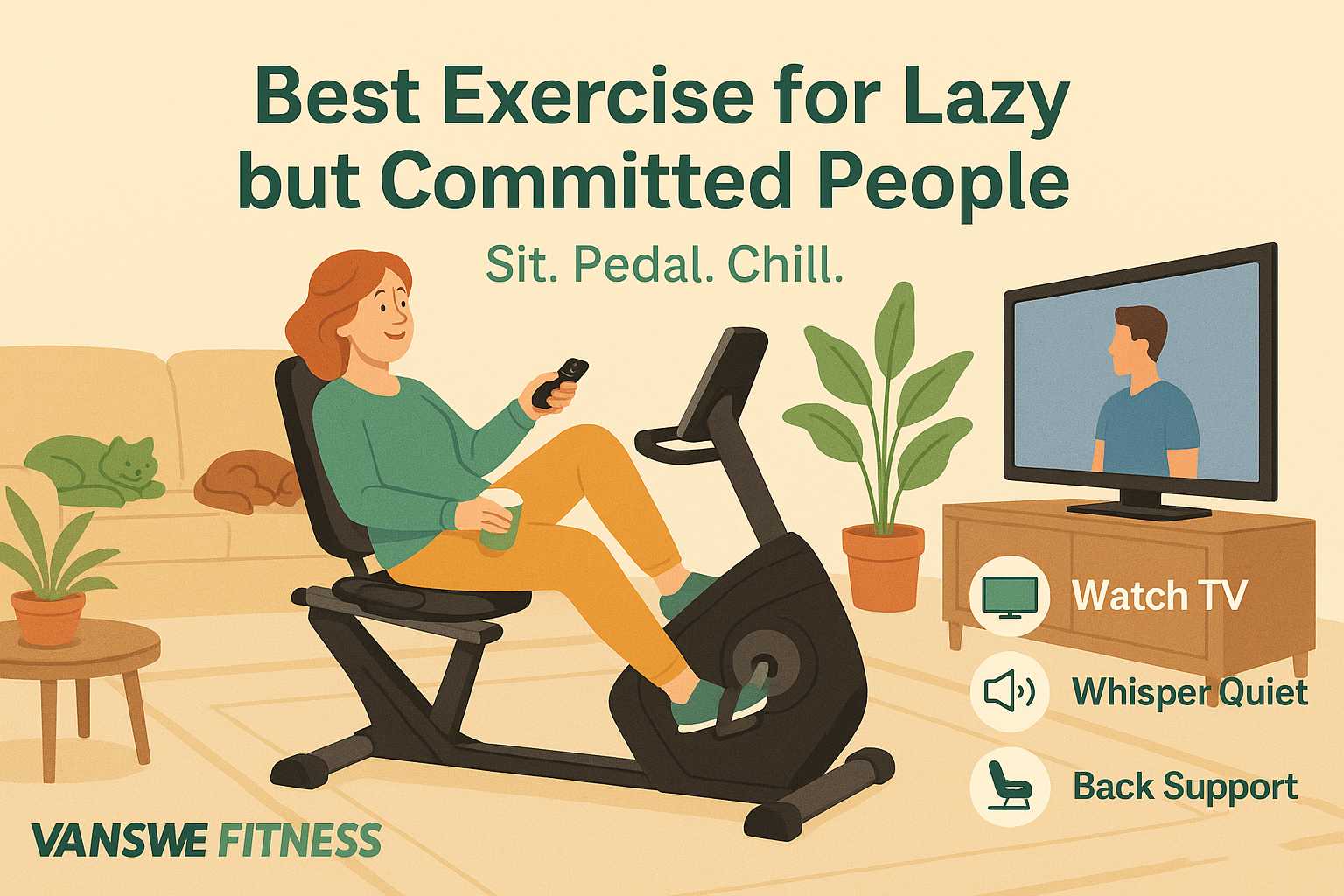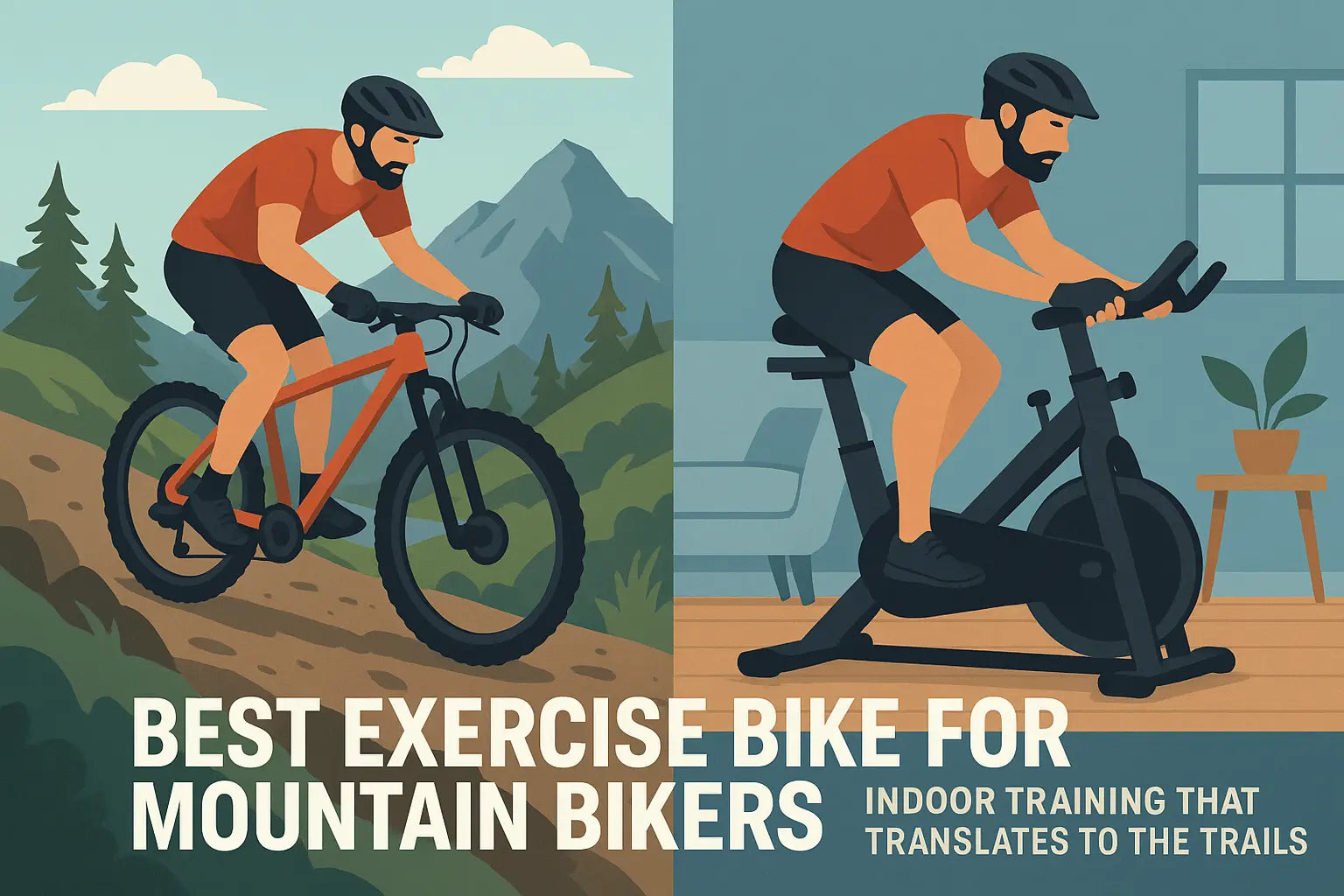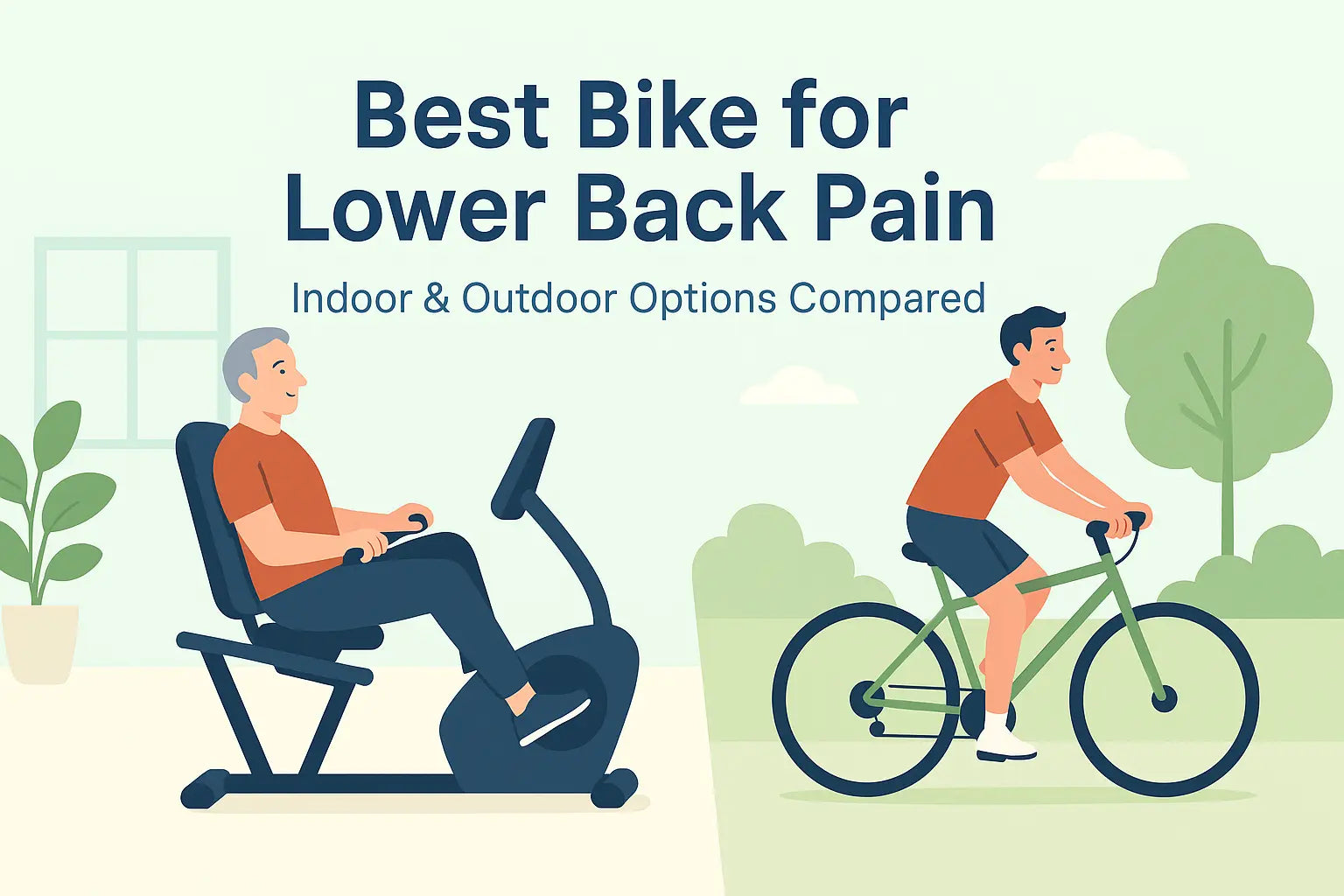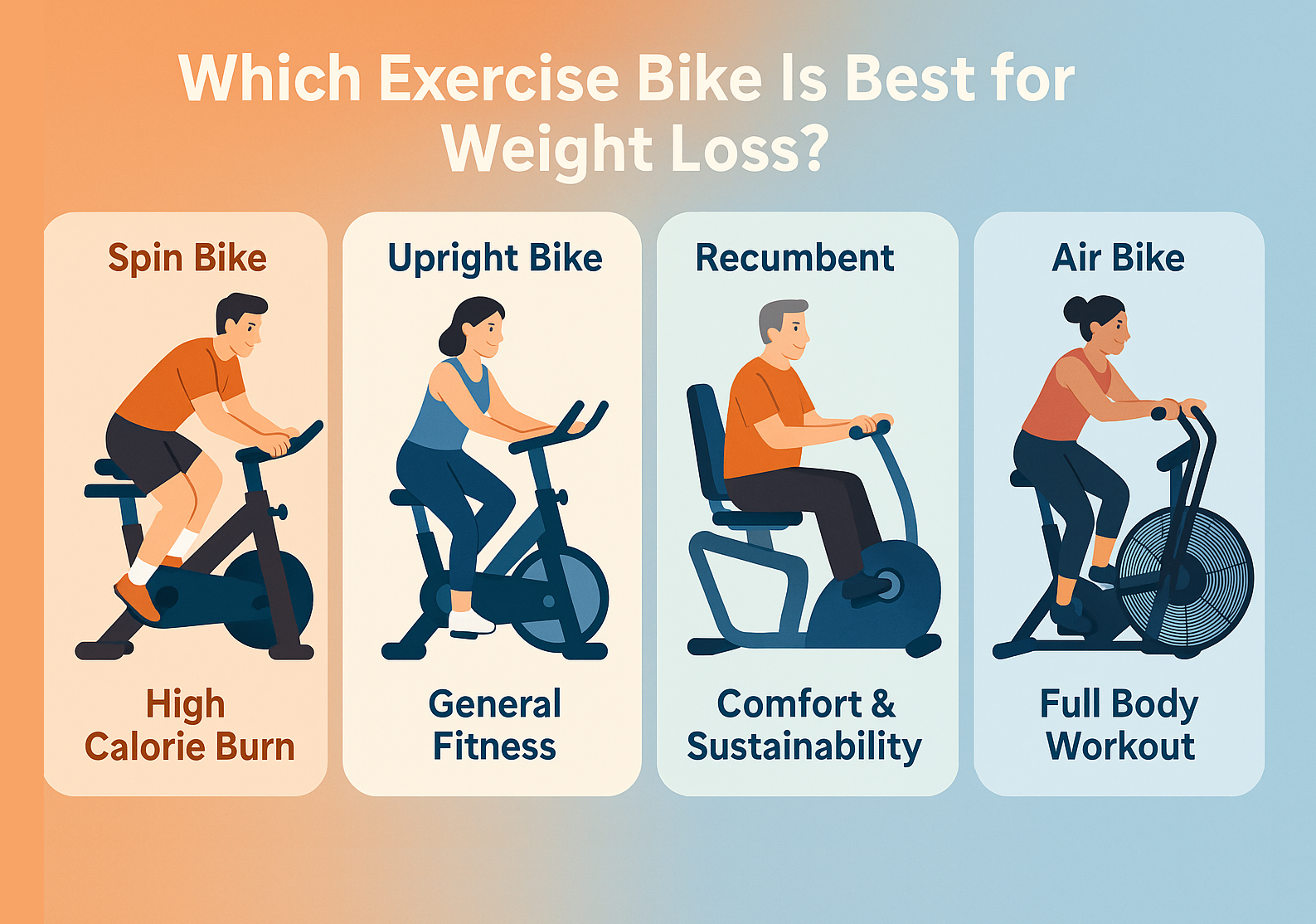Thinking about starting indoor cycling but not sure which is better: a recumbent bike or an upright bike? With so many options, it’s easy to feel uncertain about which type fits your needs. Both provide excellent cardio workouts, but their designs create very different riding experiences. As a Vanswe recumbent bike specialist, I’ll break down the key differences so you can choose the bike that best supports your fitness goals.
Recumbent Bike vs Upright Bike: Basic Info
What's an Upright Bike?
An upright bike is a stationary exercise bike where you sit in a vertical position, similar to riding a regular outdoor bicycle, and it mainly provides a cardio workout that engages your legs and core. It originated from road bikes and was first used indoors by cyclists during off-season training. Soon it became popular in gyms in the 1970s for intense cardio workouts.
What's a Recumbent Bike?
A recumbent bike is a stationary exercise bike with a reclined seat and backrest that provides low-impact cardio while supporting your back and joints. It was developed later than the upright bike, with a focus on rehabilitation and ergonomic comfort. Initially used in medical settings, they’ve since become a preferred option for seniors and users seeking low-impact exercise.
Although both are indoor cardio machines, their designs differ significantly.
Bike Structure Difference
| Feature | Recumbent Bike | Upright Bike |
|---|---|---|
| Seating Position | Reclined seat with feet forward; full back support | Upright posture similar to a traditional bike; no backrest |
| Pedal Placement | Pedals positioned in front; horizontal leg movement reduces knee stress | Pedals under the hips; vertical pedaling mimics outdoor cycling |
| Handlebar Design | Dual handlebars — one in front, one on each side of the seat | Single front handlebar; requires forward lean to grip |
| Mounting Ease | Low, open frame allows easy access; ideal for seniors or limited mobility | Requires leg swing to mount; better for agile users |
Recumbent Bike vs Upright Bike: Key Difference
The key difference between recumbent bike and upright bike is that a recumbent bike has a reclined seat with back support and front-positioned pedals for comfort and low-impact exercise, while an upright bike has a vertical seat like a regular bicycle, engaging more muscles but putting more strain on the back and joints.
1. Comfort and Riding Posture
Upright bikes are modeled after traditional road bicycles—which also means they inherit the same posture-related discomforts. These discomforts are your body’s way of sounding the alarm. Ignoring them could lead to strain, injury, or long-term issues if left unaddressed.
The British Journal of Sports Medicine [1] reports that 40% to 85% of cyclists experience an injury each year. These range from common overuse problems to acute trauma. Even among recreational riders, research indicates that about 36% report at least one cycling-related discomfort or injury each year. Overuse injuries are the most frequent, with the knees affected in up to 60% of cases, followed by the lower back, neck, wrists, and the perineal area. These typically result from long-term pressure or an improper bike fit. Acute injuries, on the other hand, are usually caused by sudden events such as falls, collisions, or road hazards.
In contrast, most recumbent bikes offer ergonomic support, which enables users to maintain comfort over longer periods. These bikes feature a reclined seating position with legs extended in front, promoting a relaxed seating position that reduces strain on the back and joints. According to the National Institute on Aging [2], supportive exercise machines like recumbent bikes are ideal for older adults or those with back and joint issues.
2. Ease of Getting On and Off
According to the World Health Organization (WHO) and national health agencies [3], one in three adults over age 65 falls each year, and the risk increases to over 40% for those aged 80 and above. These falls often result in serious consequences such as hip fractures, head injuries, or long-term loss of independence. Many incidents occur during everyday movements—like stepping over obstacles or getting in and out of chairs or equipment. That’s why step-over height on exercise bikes plays a crucial role in safety, especially for older adults.
Upright bikes typically have a step-over height of 18 to 24 inches (45–60 cm), which requires users to lift one leg high over the frame—posing a challenge for those with limited mobility or balance issues. In contrast, recumbent bikes are designed with a step-through frame, requiring little to no leg lifting, similar to a standard chair. Take the Vanswe RB407 recumbent bike as an example—it has a step-over height of just 2 inches, making it easy to mount with minimal effort.
| Feature | Upright Bike | Recumbent Bike |
| Step-Over Height | 18–24 in (45–60 cm) | 2–5 in (Step-through design) |
| Seat Height | Similar to traditional bicycle | 16–22 in (40–55 cm) |
| Getting On/Off | Requires lifting leg over frame | Walk-in access, minimal effort |
| Fall Risk for Seniors | Higher due to mounting difficulty | Lower due to easy seat access |
3. Muscle Engagement and Intensity
Both recumbent and upright bikes work the glutes, thighs, hamstrings, and calves, but upright bikes also engage the core, arms, shoulders, and back for a more full-body workout. [4]
Upright bikes engage a wider range of muscles, including:
-
Biceps and triceps (through upright posture and handlebar support)
-
Shoulders and arms (from maintaining balance and grip)
-
Core and abs (due to the need for trunk stabilization)
-
Glutes, thighs, and calves (similar to recumbent bikes but with greater intensity)
In contrast, recumbent bikes primarily target muscles:
-
Quadriceps and hamstrings (via forward pedaling motion)
-
Glutes and calves (with less intensity than upright bikes)
-
Minimal upper body and core engagement due to the supported, reclined position
4. Joint Impact and Safety
Joint problems are extremely prevalent among seniors, particularly in the knees. According to the Centers for Disease Control and Prevention (CDC) [5], over 49.6% of adults aged 65 and older have been diagnosed with arthritis, with the knee joint being the most commonly affected area. The National Council on Aging [6] also identifies osteoarthritis as one of the most widespread chronic conditions in older adults, commonly affecting the knees, hips, hands, and spine. Epidemiological studies show that between 33% and 50% of seniors experience persistent knee pain or mobility issues, often leading to difficulty walking, climbing stairs, or standing for long periods.
For older adults, choosing a joint-friendly workout machine isn’t just a preference—it’s essential. Upright bikes often place more stress on the knees, hips, and spine, which can make them less suitable. Recumbent bikes, by contrast, ease joint strain for three key biomechanical reasons.
a) Less Stress on the Knees: Smaller Joint Angles, Lower Pressure
On an upright bike, your knees bend deeply with each pedal stroke—usually between 75° and 105°. This puts more pressure and friction on the kneecap and surrounding cartilage.
Recumbent bikes, however, allow your legs to extend forward, keeping the knee angle lower (around 45° to 70°). Smaller angles reduce compression, protecting cartilage and easing long-term wear—especially for arthritis or knee pain.
b) Neutral Hip Position: Less Strain on Hip Flexors
Upright bikes keep the hips in a bent position, which can overwork the hip flexors and cause tightness or pelvic tilt.
Recumbent bikes support a more neutral, relaxed hip angle, reducing the pull on those muscles and lowering the risk of hip impingement or lower back discomfort.
c) Better Spine and Pelvic Support: Backrest Reduces Strain
Upright bikes force a forward lean, which can strain the lower back and pelvis over time.
Recumbent bikes solve this with a supportive backrest that stabilizes the spine, eases disc pressure, and helps users with back pain or degenerative conditions.
5. Cardiovascular Fitness Benefits
Both upright and recumbent bikes can improve cardiovascular health by strengthening the heart and regulating blood pressure, as recommended by the American Heart Association [7]. The difference lies in how they achieve it.
Upright bikes provide more intense workouts that build endurance and challenge the cardiovascular system, making them a strong choice for fitness enthusiasts. Recumbent bikes, on the other hand, deliver the same heart-health benefits with less joint stress and greater comfort.
6. Weight Loss and Calorie Burn
Upright bikes generally burn more calories than recumbent bikes because they allow for higher workout intensity. They engage a wider range of muscles, offer the option of high-intensity interval training (HIIT), and can produce a greater calorie burn over shorter sessions. This makes upright bikes a strong choice for people focused on fast or significant weight loss.
Recumbent bikes, while burning fewer calories per minute, are often easier to use for longer periods of time. Many riders find they can comfortably cycle for 45 to 60 minutes, which is much longer than an upright bike. Over time, this consistency can result in meaningful calorie burn and steady weight loss. For those who value comfort, safety, or joint protection, recumbent bikes provide a sustainable path to weight management.
Source: American Council on Exercise (ACE) – “HIIT vs. Steady-State Training: Which One is Best for Your Clients??” [8]
7. Space Requirement and Price
As a recumbent bike specialist, part of my daily work involves tracking market trends and product data. Below is a comparison I compiled showing the top 10 best-selling recumbent and upright bikes on Amazon US for July 2025, including their footprints and price points.
Upright Bike Space & Price Table
| Price | Footprint | Type | SQFT |
| $209.99 | 40 x 22 | 6.11 | |
| $129.99 | 31.9 x 17.7 | Foldable | 3.92 |
| $189.99 | Unlabeled | ||
| $111.99 | 49 x 16 | Foldable | 5.44 |
| $123.49 | 27.56 x 15.95 | Foldable | 3.05 |
| $179.00 | 44.5 x 19.3 | 5.96 | |
| $136.99 | 34.65 x 12.29 | Foldable | 2.96 |
| $129.99 | 27.17 x 15.75 | Foldable | 2.97 |
| $799.00 | 48.7 x 21.2 | 7.17 | |
| $114.99 | 31.9 x 15.94 | Foldable | 3.53 |
Recumbent Bike Space & Price Table
| Price | Footprint | SQFT |
| 199.99 | 25.4 x 48.3 | 8.52 |
| 199.99 | 51.97 x 25 | 9.02 |
| 399.99 | 50 x 23 | 7.99 |
| 199.99 | Unlabeled | |
| 199.99 | 43 x 20 | 5.97 |
| 169.99 | 53 x 19.3 | 7.10 |
| 199.99 | 48.3 x 25.4 | 8.52 |
| 151.98 | 56 x 25 | 9.72 |
| 209.99 | 51.38 x 26.58 | 9.48 |
| 349.99 | 43 x 18.5 | 5.52 |
Note: The information in this chart is time-sensitive. It's common to see product specs may be reduced as prices decrease.
Looking at the top 10 best-selling upright bikes, 4 are standard upright models, while 6 are foldable upright bikes. Foldable versions are notably more compact and budget-friendly compared to recumbent bikes. On the other hand, standard upright bikes and recumbent bikes are fairly similar in both size and price.
Foldable upright bikes typically have a footprint of 3 to 5 square feet and fold down to about 2 sqft for easy storage. Standard upright bikes usually take up 6 to 7 sqft, whereas recumbent bikes require a larger space—usually between 8 and 9 sqft.
In terms of pricing, foldable upright bikes average around $120, while both standard upright and recumbent bikes tend to sit near the $200 mark. Many people still think recumbent bikes are pricey, but that belief comes from the early models, which were mainly built for rehab clinics and commercial gyms—so they cost a lot more. Now the market has changed, and there are plenty of affordable recumbent bikes designed for home use.
Conclusion: Which is Better?
Recumbent bikes are especially popular among seniors, thanks to their comfort and joint support, while upright bikes usually attract those looking for higher intensity and calorie burn.
When selecting a bike, consider factors such as your budget, available space, and the intensity of the workouts you plan to perform. Considering these factors will help you make an informed decision that aligns with your fitness goals and ensures a satisfying exercise experience.
Related Articles:
Recumbent Bike Benefits for Seniors: 7 Benefits You Shouldn't Miss
Recumbent Bike Weight Loss Benefits: Compared to Other Cardio Options
FAQ
What is better a recumbent bike or an upright bike for knee rehab?
A recumbent bike is better than an upright bike for knee rehab because its reclined seat and forward pedals reduce joint strain while supporting proper leg alignment.
Reference
- Rooney, D., Sarriegui, I., & Heron, N. (2020). 'As easy as riding a bike': a systematic review of injuries and illness in road cycling. BMJ open sport & exercise medicine, 6(1), e000840. https://doi.org/10.1136/bmjsem-2020-000840
- National Institute on Aging. (2025, January 14). Exercising with chronic conditions. U.S. Department of Health & Human Services. https://www.nia.nih.gov/health/exercise-and-physical-activity/exercising-chronic-conditions
- Ikpeze, T. C., Glaun, G., McCalla, D., & Elfar, J. C. (2018). Geriatric Cyclists: Assessing Risks, Safety, and Benefits. Geriatric orthopaedic surgery & rehabilitation, 9, 2151458517748742. https://doi.org/10.1177/2151458517748742
- Bouillon, L., Baker, R., Gibson, C., Kearney, A., & Busemeyer, T. (2016). COMPARISON OF TRUNK AND LOWER EXTREMITY MUSCLE ACTIVITY AMONG FOUR STATIONARY EQUIPMENT DEVICES: UPRIGHT BIKE, RECUMBENT BIKE, TREADMILL, AND ELLIPTIGO®. International journal of sports physical therapy, 11(2), 190–200.
- Theis, K. A., Murphy, L. B., Guglielmo, D., Boring, M. A., Okoro, C. A., Duca, L. M., & Helmick, C. G. (2021, October 8). Prevalence of arthritis and arthritis‑attributable activity limitation — United States, 2016–2018. Morbidity and Mortality Weekly Report, 70(40), 1401–1407. Retrieved from https://www.cdc.gov/mmwr/volumes/70/wr/mm7040a2.htm
- Ambrose, K. (2023, February 17). Why older adults shouldn’t ignore an osteoarthritis diagnosis. National Council on Aging. Retrieved from https://www.ncoa.org/article/why-older-adults-shouldnt-ignore-an-osteoarthritis-diagnosis/
- American Heart Association. (n.d.). American Heart Association recommendations for physical activity in adults and kids. https://www.heart.org/en/healthy-living/fitness/fitness-basics/aha-recs-for-physical-activity-in-adults
- Mayo Clinic Staff. (n.d.). Weight loss: Choosing a diet that's right for you. Mayo Clinic. https://www.mayoclinic.org/healthy-lifestyle/weight-loss/in-depth/weight-loss/art-20048466
Latest Articles







